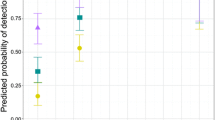Summary
Ten species of Pheidole, representing as many species groups from various localities in North and South America, Asia, and Africa, were analyzed to probe for possible relationships between caste ratios and division of labor.
Minor workers are behaviorally almost uniform among the species, but major workers vary in repertory from 4 to 19 behavioral acts (Table 1, Fig. 2). The major repertory size increases significantly across the species with the percentage of majors in the worker force (Fig. 3). This trend is consistent with the basic prediction of ergonomic optimization models under an assumption of colony-level selection. There is also a trend toward reduction of behavioral repertory with increase of size in the major relative to the minor, a second relation expected from theory, but the data are not sufficient to reach statistical significance.
When the minor:major ratio was lowered to below 1:1 (from the usual 3:1 to 20:1, according to species), in three widely different species (guilelmimuelleri, megacephala, pubiventris), the repertory size increased by 1.4–4.5X and the rate of activity by 15–30X (Table 1, Figs. 4–6). The change occurred within 1 h of the ratio change and was reversed in comparably short time when the original ratio was restored.
This abrupt and important shift in behavior permitted the major workers to serve as an emergency stand-by caste, available to be summoned to a nearly full repertory when the minor worker caste was depleted. The majors also restored 75% or more of the missing minor workers' activity rate under laboratory conditions. Their transformation allowed continued oviposition by the queen and the rearing of larvae to the adult stage.
In line with these findings, a distinction is made between programmed “elasticity” in the repertory of individual workers and castes and the “resiliency” of the colony as a whole, which depends upon the pattern of caste-specific elasticity.
Similar content being viewed by others
References
Bhatkar A, Whitcomb WH (1970) Artificial diet for rearing various species of ants. Fla Entomol 53:229–232
Bruch C (1916) Contribución al estudio de las hormigas de la Provincia de San Luis. Rev Mus La Plata, Argentina 23:291–354
Buckingham E (1911) Division of labor among ants. Proc Am Acad Art Sci 56:425–507
Calabi P, Traniello JFA, Werner MH (1983) Age polyethism: its occurrence in the ant Pheidole hortensis, and some general considerations. Psyche 90:395–412
Droual R (1983) The organization of nest evacuation in Pheidole desertorum Wheeler and P. hyatti Emery (Hymenoptera: Formicidae). Behav Ecol Sociobiol 12:203–208
Fagen RM, Goldman RN (1977) Behavioural catalogue analysis methods. Anim Behav 25:261–274
Oster GF, Wilson EO (1978) Caste and ecology in the social insects. Princeton University Press, Princeton, NJ
Wheeler D, Nijhout F (1984) Soldier determination in Pheidole bicarinata: inhibition by adult soldiers. J Insect Physiol 30:127–135
Wheeler WM (1928) Mermis parasitism and intercastes among ants. J Exp Zool 50:165–237
Wilson EO (1968) The ergonomics of caste in the social insects. Am Nat 102:41–66
Wilson EO (1976a) Which are the most prevalent ant genera? Stud Entomol 19:187–200
Wilson EO (1976b) The organization of colony defense in the ant Pheidole dentata Mayr (Hymenoptera: Formicidae). Behav Ecol Sociobiol 1:63–81
Wilson EO (1976c) Behavioral discretization and the number of castes in an ant species. Behav Ecol Sociobiol 1:141–154
Wilson EO (1980) Caste and division of labor in leaf-cutter ants (Hymenoptera: Formicidae: Atta). II. The ergonomic optimization of leaf cutting. Behav Ecol Sociobiol 7:157–165
Wilson EO (1983) Caste and division of labor in leaf-cutter ants (Hymenoptera: Formicidae: Atta). III. Ergonomic resiliency in foraging by A. cephalotes. Behav Ecol Sociobiol 14:47–54
Author information
Authors and Affiliations
Rights and permissions
About this article
Cite this article
Wilson, E.O. The relation between caste ratios and division of labor in the ant genus Pheidole (Hymenoptera: Formicidae). Behav Ecol Sociobiol 16, 89–98 (1984). https://doi.org/10.1007/BF00293108
Received:
Accepted:
Issue Date:
DOI: https://doi.org/10.1007/BF00293108




